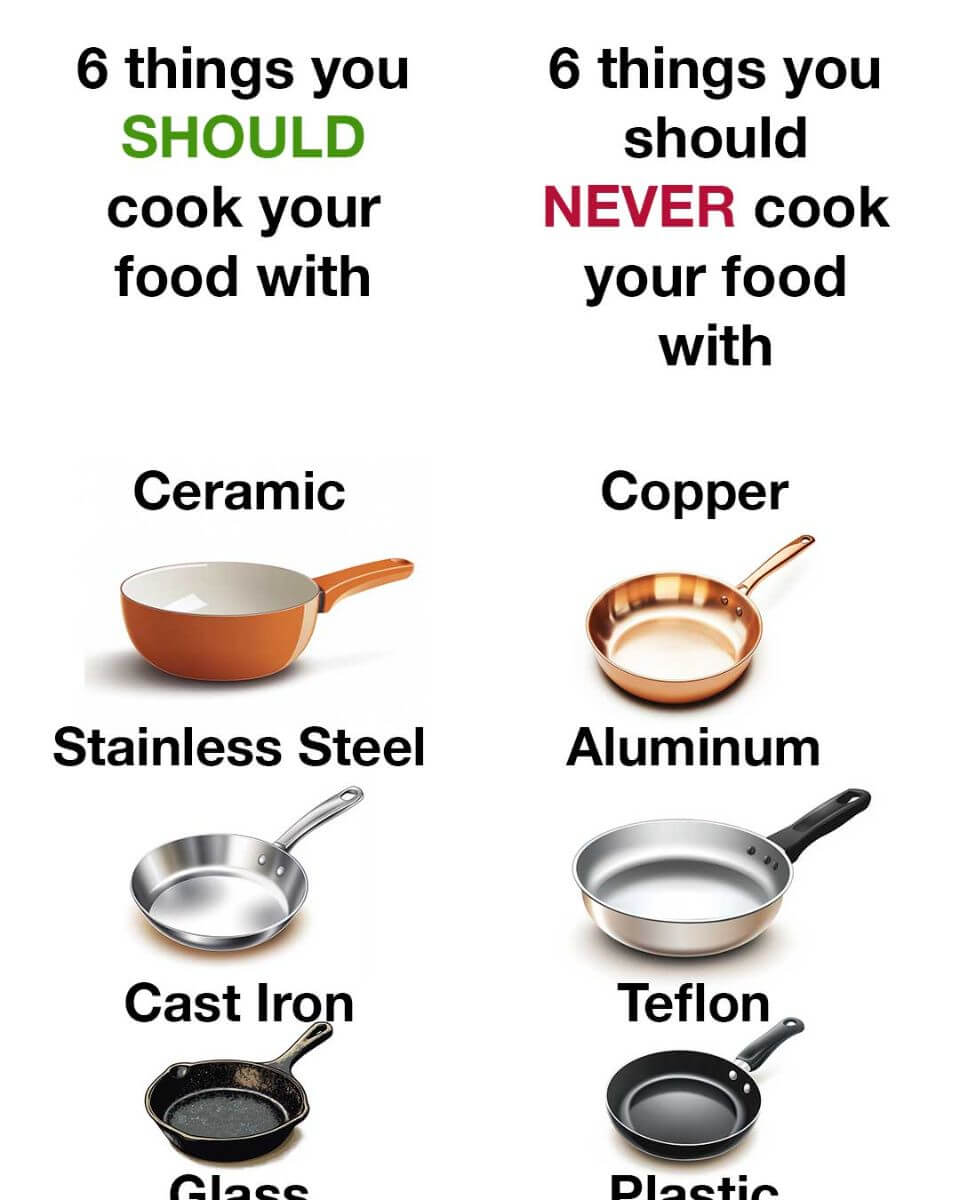Cooking is more than just selecting fresh ingredients; the materials you cook with play a vital role in the taste, nutrition, and safety of your food. With a wide range of cookware options available, understanding which materials are beneficial and which ones pose risks can make all the difference. Below, we explore six materials that are excellent for cooking and six that should be avoided.
6 Cookware Materials You Should Use
Using the right cookware can enhance your meals by ensuring even cooking, preserving flavors, and maintaining safety. Here are six materials highly recommended for their durability and non-toxic nature.
1. Ceramic: A Safe and Even-Heating Option
Ceramic cookware is a fantastic choice due to its non-reactive surface, meaning it won’t release harmful chemicals into your meals. It distributes heat evenly, making it perfect for slow-cooked dishes. Additionally, many ceramic options feature a naturally non-stick surface, allowing for healthier cooking with less oil.
2. Stainless Steel: A Reliable and Long-Lasting Material
Stainless steel is widely used in kitchens due to its resilience against rust and corrosion. It does not interact with acidic foods, ensuring that flavors remain unchanged. This material is easy to clean, withstands high temperatures, and is ideal for everything from searing meat to boiling pasta.
3. Cast Iron: A Timeless and Nutritious Choice
Cast iron is celebrated for its ability to retain and evenly distribute heat, making it perfect for frying, baking, and roasting. When seasoned properly, it develops a natural non-stick surface. Additionally, cooking with cast iron can increase iron intake, which is beneficial for those with iron deficiencies.
4. Glass: A Non-Toxic and Flavor-Preserving Option
Glass cookware is completely non-reactive, meaning it won’t leach chemicals or affect the taste of food. It’s particularly great for baking and food storage, as it doesn’t retain odors or flavors from previous meals. The transparency also allows for easy monitoring while cooking.
5. Enamel-Coated Cookware: A Versatile and Stylish Choice
Enamel cookware combines the heat-retention benefits of cast iron with a smooth, easy-to-clean surface. It does not react with acidic foods, making it an excellent choice for tomato-based dishes and stews. Plus, enamel cookware comes in vibrant colors, adding a touch of style to your kitchen.
6. Carbon Steel: Lightweight and Professional-Grade
Similar to cast iron but lighter, carbon steel heats up quickly and responds well to temperature changes. It’s favored by professional chefs for stir-frying, sautéing, and high-heat cooking. Over time, carbon steel develops a natural non-stick patina, improving with use.
6 Cookware Materials to Avoid
While some cookware materials enhance cooking, others can introduce harmful chemicals into your meals or degrade over time. Here are six materials best avoided in the kitchen.
1. Copper: Beautiful but Potentially Harmful
Copper cookware conducts heat exceptionally well but can leach into food when unlined, leading to potential toxicity. If using copper cookware, ensure it’s lined with stainless steel to prevent any adverse health effects.
2. Aluminum: A Reactive and Health-Concerning Material
Aluminum is lightweight and affordable, but it reacts with acidic and salty foods, causing aluminum particles to enter meals. Although anodized aluminum is a safer alternative, regular aluminum cookware should be used with caution, especially for prolonged cooking.
3. Non-Stick Coatings (Teflon): A Health Risk at High Temperatures
Non-stick cookware, particularly those coated with Teflon, can release toxic fumes when overheated. These fumes have been linked to respiratory issues and other health concerns. If using non-stick cookware, cook at lower temperatures or switch to safer alternatives like ceramic or cast iron.
4. Plastic: Unsuitable for High-Heat Cooking
Plastic utensils and cookware may contain harmful chemicals like BPA, which can seep into food when exposed to high temperatures. Even microwave-safe plastics degrade over time, making them a poor choice for cooking. Opt for glass or stainless steel instead.
5. Silicone: Best for Baking but Not for High-Heat Cooking
Silicone bakeware is popular for its flexibility and non-stick properties, but it can degrade when exposed to very high temperatures. While generally considered safe, it’s best used for baking rather than direct heat applications like frying.
6. Lead-Based Cookware: A Serious Health Hazard
Some traditional or imported cookware may contain lead, particularly in glazes used on ceramic or earthenware. Lead exposure can lead to severe health problems, including neurological damage. Always ensure your cookware is certified lead-free before using it for food preparation.
Conclusion: Choose Wisely for a Healthier Kitchen
Your choice of cookware impacts not just the taste and texture of your meals, but also your overall health. Opting for materials like ceramic, stainless steel, and cast iron can elevate your cooking while ensuring safety. On the other hand, avoiding harmful materials like unlined copper, aluminum, and non-stick coatings can help prevent health risks. By making informed decisions about your cookware, you can enjoy safer, tastier, and healthier meals for years to come.
